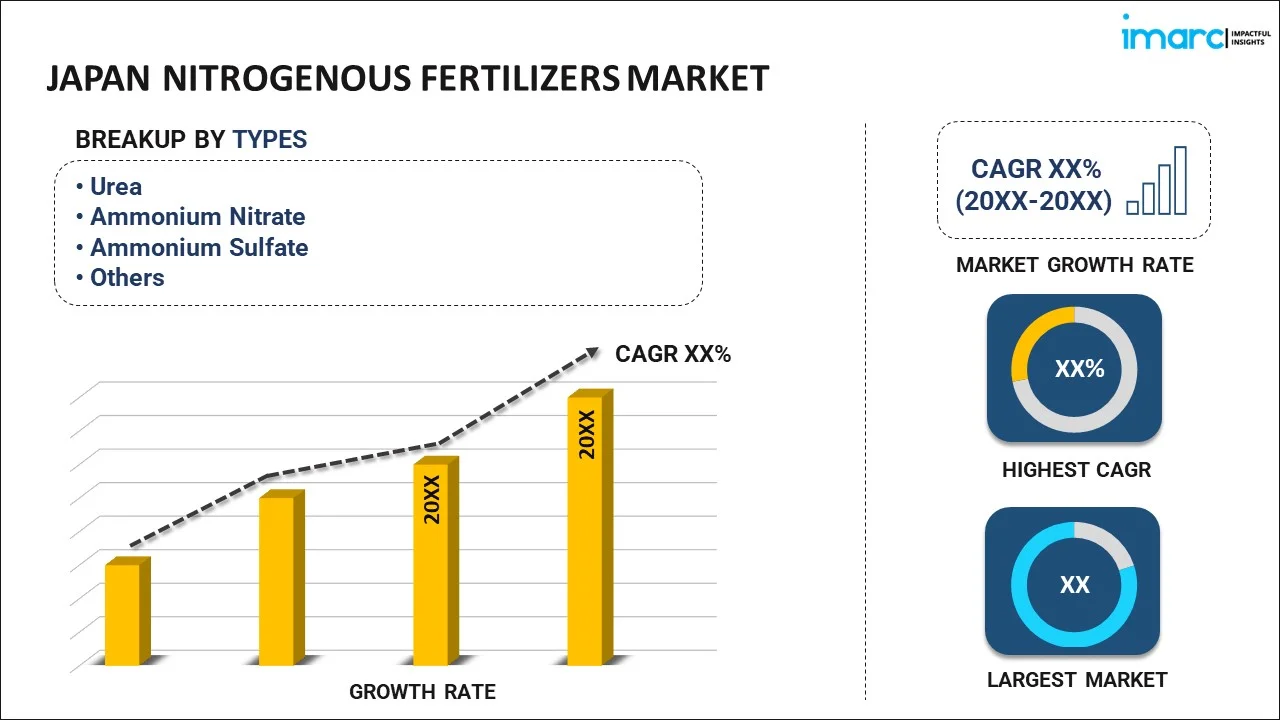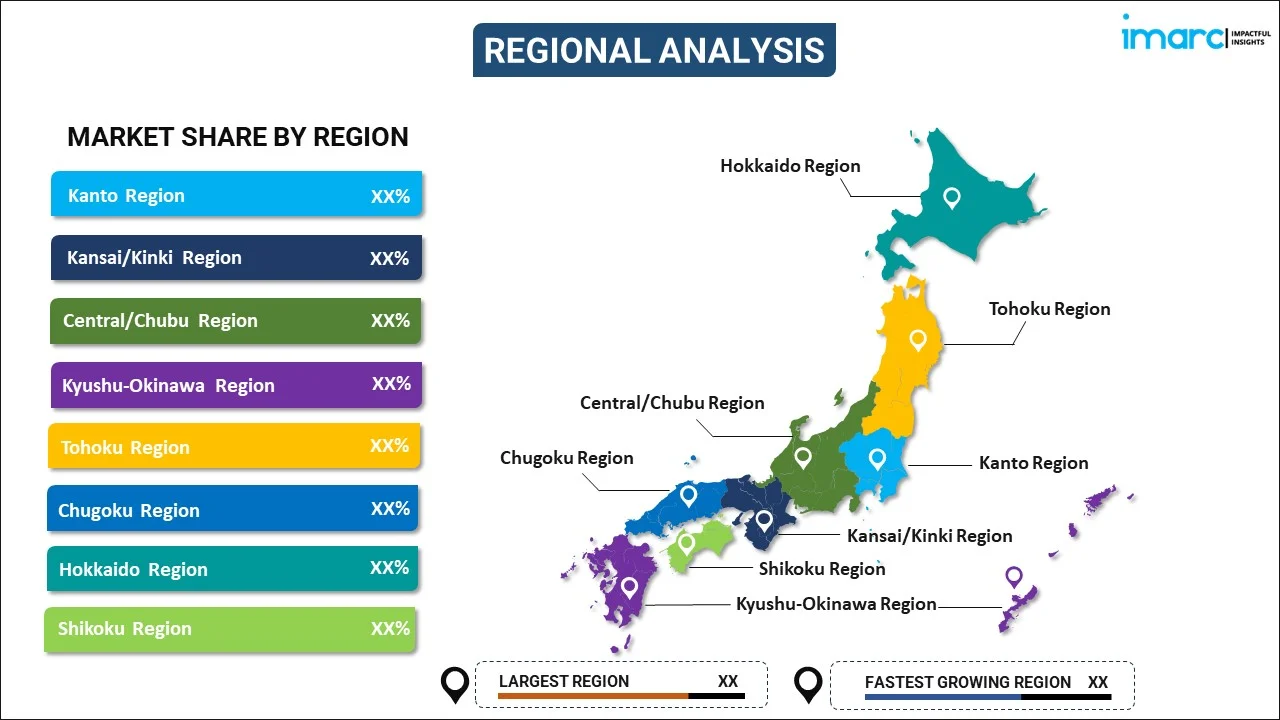
Japan Nitrogenous Fertilizers Market Report by Type (Urea, Ammonium Nitrate, Ammonium Sulfate, Calcium Ammonium Nitrate (CAN), and Others), Crop Type (Cereals and Grains, Oilseeds and Pulses, Fruits and Vegetables, and Others), Form (Liquid, Dry, and Others), Mode of Application (Soil, Foliar, Fertigation, and Others), and Region 2025-2033
Market Overview:
Japan nitrogenous fertilizers market size reached USD 2.6 Billion in 2024. Looking forward, IMARC Group expects the market to reach USD 4.1 Billion by 2033, exhibiting a growth rate (CAGR) of 4.85% during 2025-2033. The rising R&D activities in the field of fertilizers, along with the inflating need for crop protection and resilience to pests and diseases, are primarily driving the market growth.
|
Report Attribute
|
Key Statistics
|
|---|---|
|
Base Year
|
2024 |
|
Forecast Years
|
2025-2033
|
|
Historical Years
|
2019-2024
|
| Market Size in 2024 | USD 2.6 Billion |
| Market Forecast in 2033 | USD 4.1 Billion |
| Market Growth Rate (2025-2033) | 4.85% |
Nitrogen-based fertilizers are crucial inorganic substances widely used to improve crop growth by influencing characteristics such as texture, hue, and overall quality. Nitrogen, a fundamental element within these fertilizers, holds a pivotal role as a building block for protoplasm and plays a critical part in the process of photosynthesis. These fertilizers typically consist of varying proportions of ammonium nitrate, ammonium sulfate, calcium ammonium nitrate, urea, and other chemical compounds. Often combined with animal manure, they are carefully administered in precise quantities to yield benefits such as enhanced flower differentiation, accelerated shoot growth, the development of sturdy flower buds, and an overall improvement in fruit quality. These fertilizers are indispensable tools for contemporary agriculture, assisting farmers in maximizing crop yields and ensuring the production of healthier, more robust crops that can meet the demands of an expanding global population. Their strategic incorporation into farming practices is a cornerstone of sustainable and efficient agricultural production.
Japan Nitrogenous Fertilizers Market Trends:
The Japan nitrogenous fertilizers market is experiencing significant growth, primarily driven by the escalating demand for increased food production. As the population continues to grow, there is a pressing need for more efficient and productive agricultural practices, which is acting as another significant growth-inducing factor. Additionally, nitrogenous fertilizers, renowned for their high nitrogen content, play a pivotal role in boosting crop growth and overall yield, making them an essential element of modern farming methods. Besides this, changing dietary preferences and urbanization trends further contribute to the demand for diverse and high-value crops, thereby catalyzing the market growth in Japan. Furthermore, the challenges posed by climate change, such as erratic weather patterns, drought, and unpredictable rainfall, also fuel the adoption of nitrogenous fertilizers. Moreover, the integration of advanced agricultural technologies and precision farming practices is driving market growth. Apart from this, subsidies, incentives, and policies that promote the use of fertilizers are prevalent in Japan, which is anticipated to fuel the market growth over the forecasted period.
Japan Nitrogenous Fertilizers Market Segmentation:
IMARC Group provides an analysis of the key trends in each segment of the market, along with forecasts at the country level for 2025-2033. Our report has categorized the market based on type, crop type, form, and mode of application.
Type Insights:

- Urea
- Ammonium Nitrate
- Ammonium Sulfate
- Calcium Ammonium Nitrate (CAN)
- Others
The report has provided a detailed breakup and analysis of the market based on the type. This includes urea, ammonium nitrate, ammonium sulfate, calcium ammonium nitrate (CAN), and others.
Crop Type Insights:
- Cereals and Grains
- Oilseeds and Pulses
- Fruits and Vegetables
- Others
A detailed breakup and analysis of the market based on the crop type have also been provided in the report. This includes cereals and grains, oilseeds and pulses, fruits and vegetables, and others.
Form Insights:
- Liquid
- Dry
- Others
The report has provided a detailed breakup and analysis of the market based on the form. This includes liquid, dry, and others.
Mode of Application Insights:
- Soil
- Foliar
- Fertigation
- Others
A detailed breakup and analysis of the market based on the mode of application have also been provided in the report. This includes soil, foliar, fertigation, and others.
Regional Insights:

- Kanto Region
- Kansai/Kinki Region
- Central/ Chubu Region
- Kyushu-Okinawa Region
- Tohoku Region
- Chugoku Region
- Hokkaido Region
- Shikoku Region
The report has also provided a comprehensive analysis of all the major regional markets, which include Kanto Region, Kansai/Kinki Region, Central/ Chubu Region, Kyushu-Okinawa Region, Tohoku Region, Chugoku Region, Hokkaido Region, and Shikoku Region.
Competitive Landscape:
The market research report has also provided a comprehensive analysis of the competitive landscape. Competitive analysis such as market structure, key player positioning, top winning strategies, competitive dashboard, and company evaluation quadrant has been covered in the report. Also, detailed profiles of all major companies have been provided.
Japan Nitrogenous Fertilizers Market Report Coverage:
| Report Features | Details |
|---|---|
| Base Year of the Analysis | 2024 |
| Historical Period | 2019-2024 |
| Forecast Period | 2025-2033 |
| Units | Billion USD |
| Scope of the Report | Exploration of Historical Trends and Market Outlook, Industry Catalysts and Challenges, Segment-Wise Historical and Future Market Assessment:
|
| Types Covered | Urea, Ammonium Nitrate, Ammonium Sulfate, Calcium Ammonium Nitrate (CAN), Others |
| Crop Types Covered | Cereals and Grains, Oilseeds and Pulses, Fruits and Vegetables, Others |
| Forms Covered | Liquid, Dry, Others |
| Modes of Application Covered | Soil, Foliar, Fertigation, Others |
| Regions Covered | Kanto Region, Kansai/Kinki Region, Central/ Chubu Region, Kyushu-Okinawa Region, Tohoku Region, Chugoku Region, Hokkaido Region, Shikoku Region |
| Customization Scope | 10% Free Customization |
| Post-Sale Analyst Support | 10-12 Weeks |
| Delivery Format | PDF and Excel through Email (We can also provide the editable version of the report in PPT/Word format on special request) |
Key Questions Answered in This Report:
- How has the Japan nitrogenous fertilizers market performed so far and how will it perform in the coming years?
- What has been the impact of COVID-19 on the Japan nitrogenous fertilizers market?
- What is the breakup of the Japan nitrogenous fertilizers market on the basis of type?
- What is the breakup of the Japan nitrogenous fertilizers market on the basis of crop type?
- What is the breakup of the Japan nitrogenous fertilizers market on the basis of form?
- What is the breakup of the Japan nitrogenous fertilizers market on the basis of mode of application?
- What are the various stages in the value chain of the Japan nitrogenous fertilizers market?
- What are the key driving factors and challenges in the Japan nitrogenous fertilizers?
- What is the structure of the Japan nitrogenous fertilizers market and who are the key players?
- What is the degree of competition in the Japan nitrogenous fertilizers market?
Key Benefits for Stakeholders:
- IMARC’s industry report offers a comprehensive quantitative analysis of various market segments, historical and current market trends, market forecasts, and dynamics of the Japan nitrogenous fertilizers market from 2019-2033.
- The research report provides the latest information on the market drivers, challenges, and opportunities in the Japan nitrogenous fertilizers market.
- Porter's five forces analysis assist stakeholders in assessing the impact of new entrants, competitive rivalry, supplier power, buyer power, and the threat of substitution. It helps stakeholders to analyze the level of competition within the Japan nitrogenous fertilizers industry and its attractiveness.
- Competitive landscape allows stakeholders to understand their competitive environment and provides an insight into the current positions of key players in the market.
Need more help?
- Speak to our experienced analysts for insights on the current market scenarios.
- Include additional segments and countries to customize the report as per your requirement.
- Gain an unparalleled competitive advantage in your domain by understanding how to utilize the report and positively impacting your operations and revenue.
- For further assistance, please connect with our analysts.
 Inquire Before Buying
Inquire Before Buying
 Speak to an Analyst
Speak to an Analyst
 Request Brochure
Request Brochure
 Request Customization
Request Customization




.webp)




.webp)












